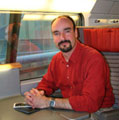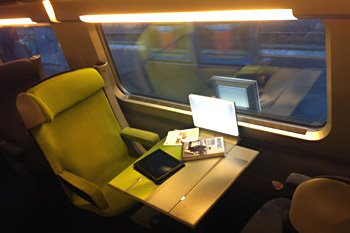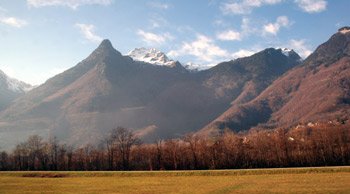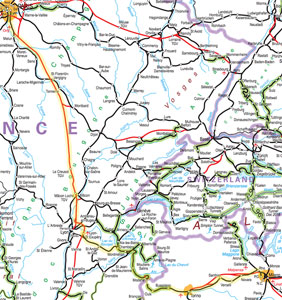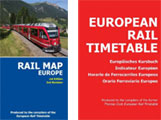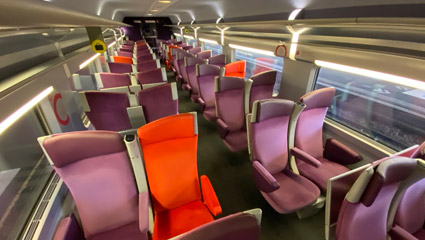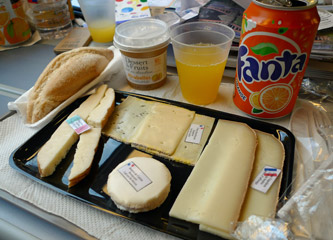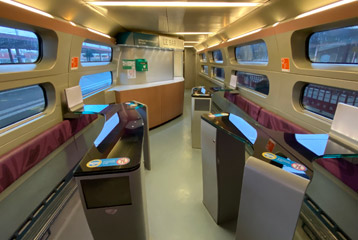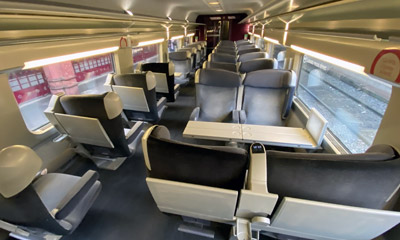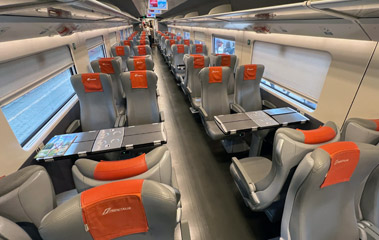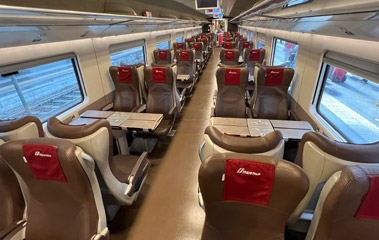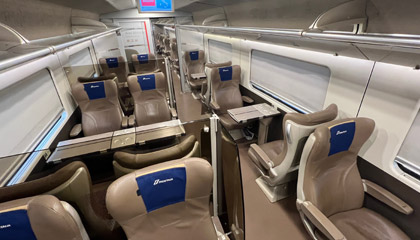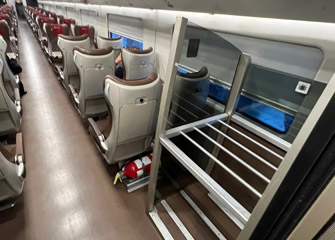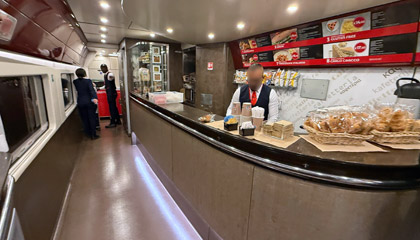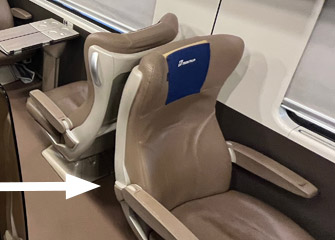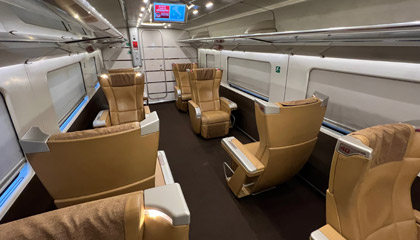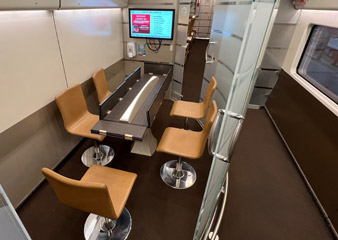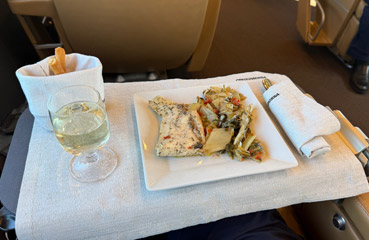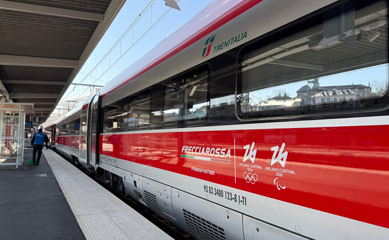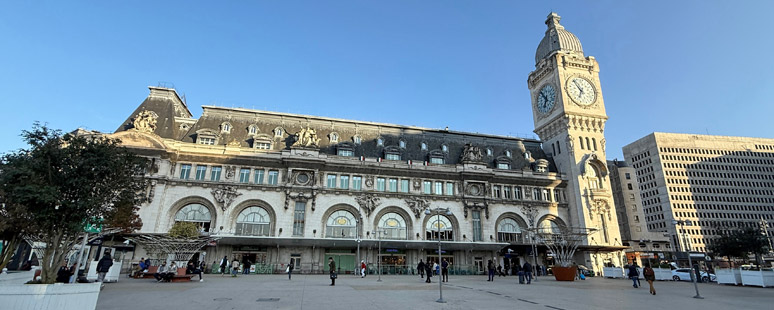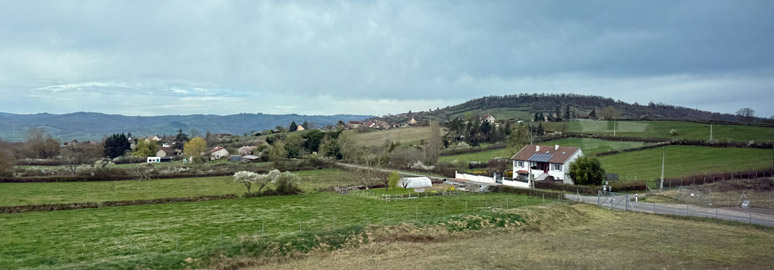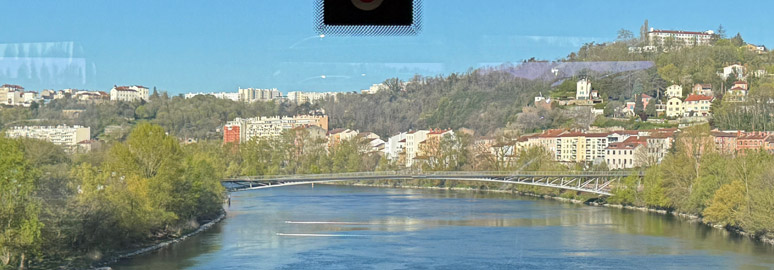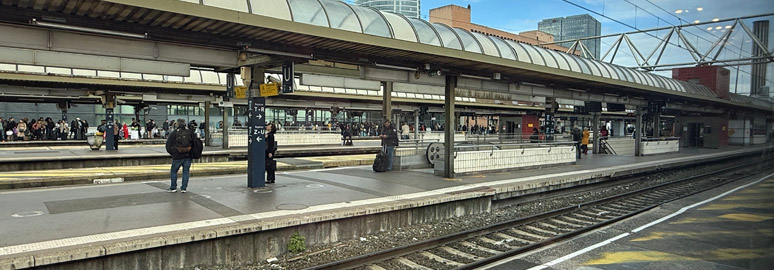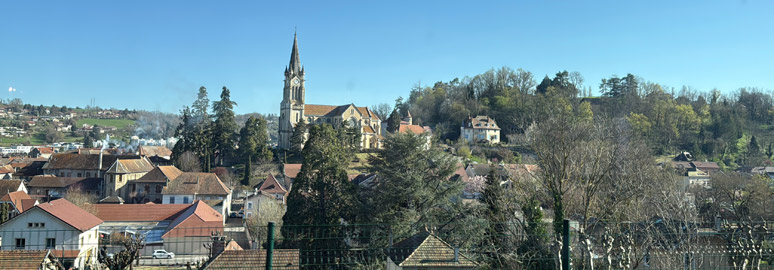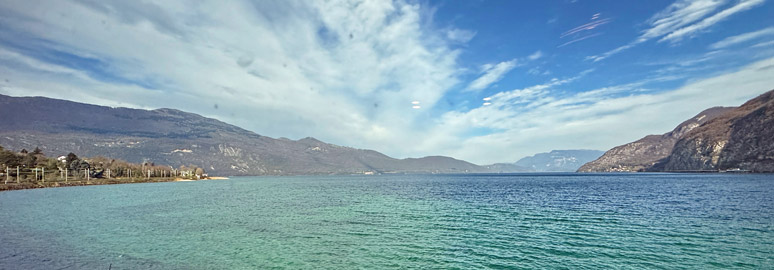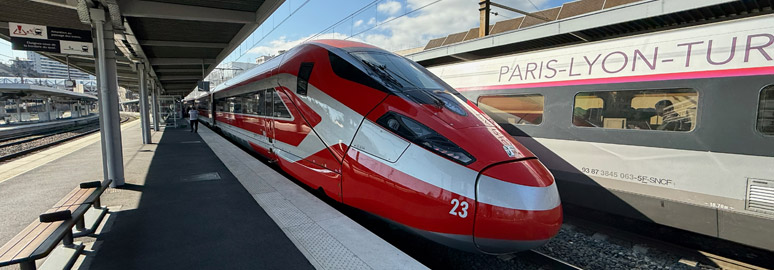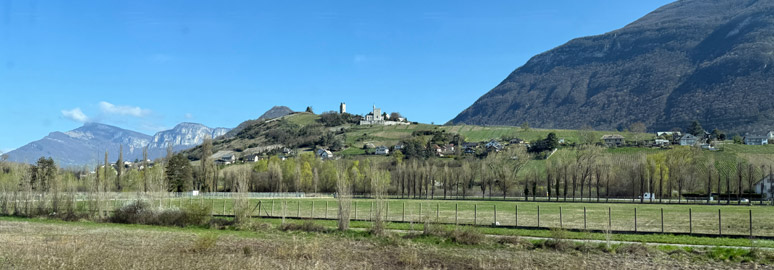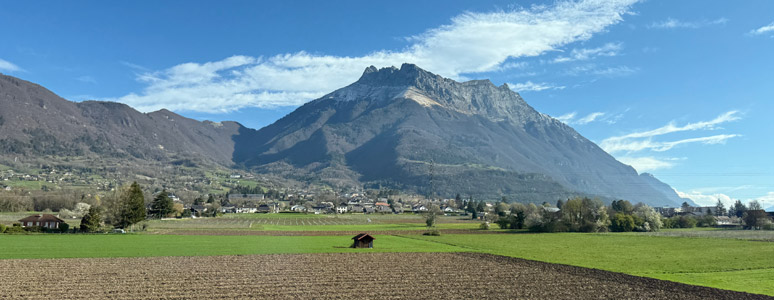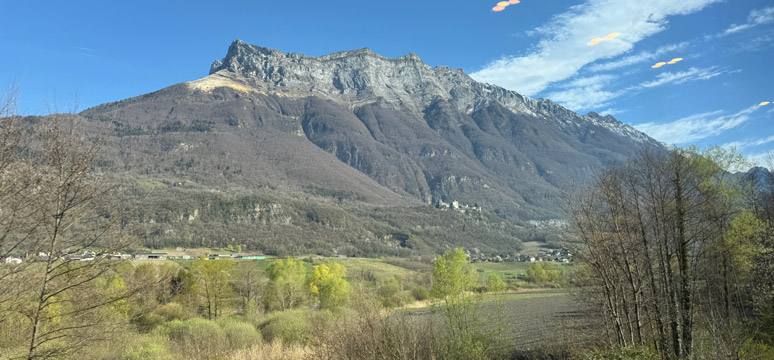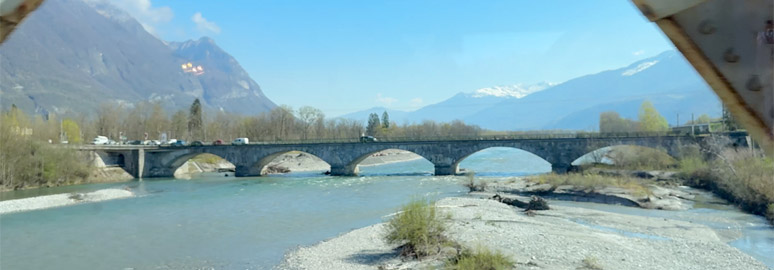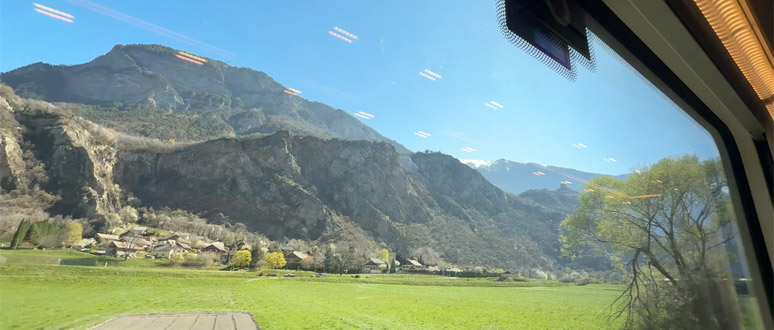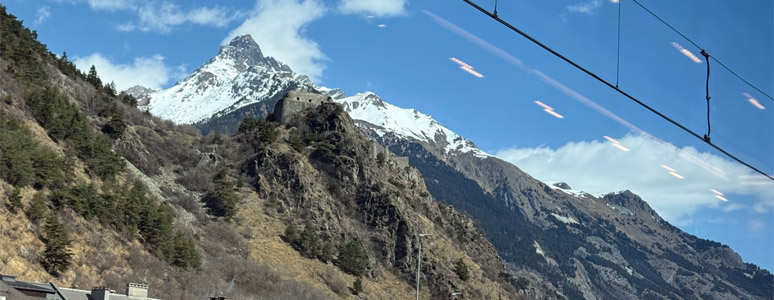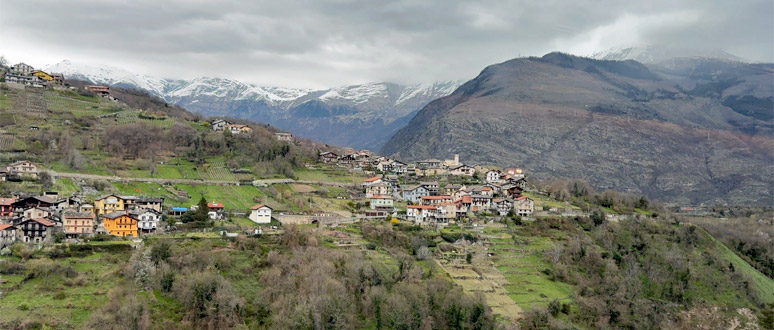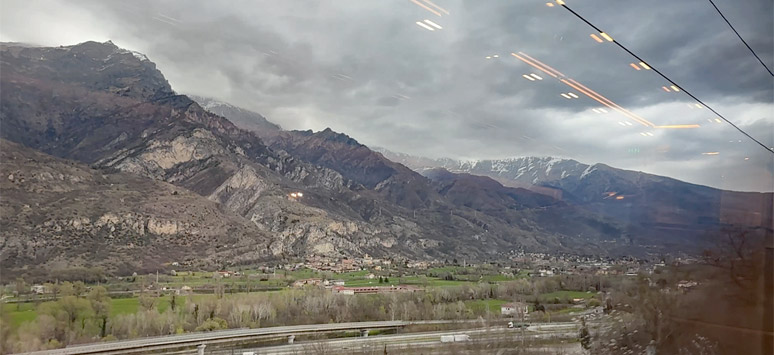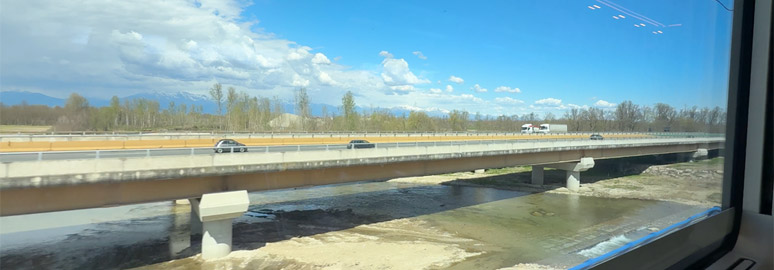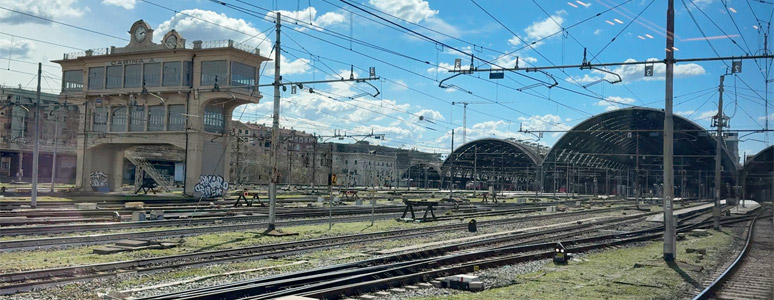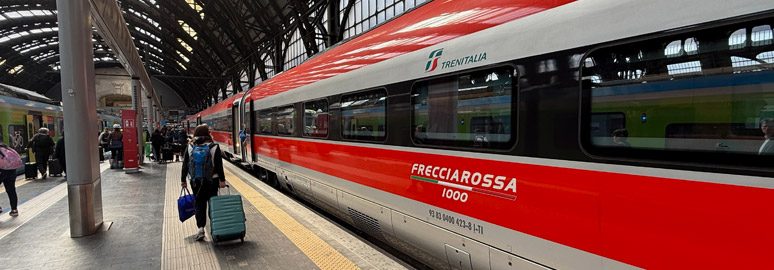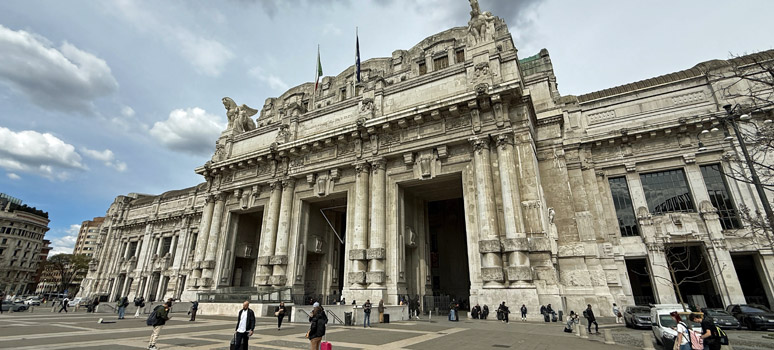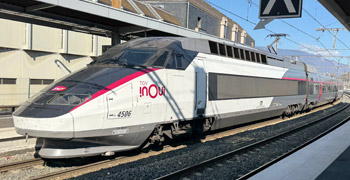 |
|
|
Italy here we come! Paris to Milan by TGV
Italy the civilised way. A face-to-face table for two in 1st class on the TGV to Milan.
Italy the scenic way. A 300 km/h dash on the high-speed line, then a slow meander through the French Alps into Italy. See the photos. Watch the video! |
Paris to Italy from €35
Every day, three TGV (Train à Grande Vitesse) high-speed trains link Paris with Turin & Milan, run by SNCF (French Railways). Since 2021 they've faced competition from two superb high-speed Frecciarossa trains run by Trenitalia (Italian Railways).
Whether you choose TGV or Frecciarossa, it's an exhilarating dash from Paris to Lyon at up to 300 km/h (186 mph) followed by a leisurely scenic meander through the French Alps on the classic line into Italy.
Change in Turin or Milan for Venice, Florence & Rome: The civilised & scenic way from Paris to Italy, without the pain of the plane. Watch the video. There is currently no sleeper train.
Timetable southbound 2026
Timetable northbound 2026
Notes for the timetable
Times vary slightly on different dates, especially the French TGV, check times when you book.
TGV = Train à Grande Vitesse, a high-speed train run by SNCF (French Railways).
Frecciarossa = High-speed Frecciarossa train run by Trenitalia (Italian Railways).
Paris to Turin by Frecciarossa is 739 km (459 miles). Paris to Milan is 881 km (547 miles).
Check trains for your date at www.raileurope.com or www.thetrainline.com. For connections to/from London, see the London to Italy page.
Connections from Paris to Venice, Florence, Rome, Naples: Paris to Venice, Paris to Florence, Paris to Rome, Paris to Naples
Connections from Venice, Florence, Rome, Naples to Paris: Venice to Paris, Florence to Paris, Rome to Paris, Naples to Paris
How much does it cost?
Return fares are twice the one-way.
Advance-purchase = book in advance, price varies like air fares, TGV advance fares mean limited/no refunds.
All Frecciarossa fares are refundable less 20%, so can be cancelled & changed.
Child fare = Child 4-11 years (TGV) or 4-13 years (Frecciarossa). Use an adult advance-purchase fare if cheaper. Children under 4 free.
Interrail/Eurail fare: This is what you pay if you have a Eurail or Interrail pass. The Frecciarossa isn't covered by Interrail/Eurail.
How to buy tickets
Which website should you use?
All these websites charge the same fares, but some add a booking fee, some don't, some offer seating options, some allocate your seat.
Option 1, www.raileurope.com
Easy to use, in plain English, in €, £ or $, small booking fee. It can book both TGV & Frecciarossa and onward trains in Italy, both Trenitalia & Italo. Offers basic seating options. You can book between Paris and almost anywhere in Italy as one booking. Who are Raileurope?
Option 2, www.thetrainline.com
Easy to use, in plain English, in €, £ or $, small booking fee. It can book both TGV & Frecciarossa and onward trains in Italy, both Trenitalia & Italo, so you can book between Paris and almost anywhere in Italy as one booking. You can choose your seat from a seat map for a small fee when booking the Frecciarossa or an onward Trenitalia high-speed train. You can choose your seat from a seat map for free when booking 1st class on the TGV. Who are Thetrainline?
Option 3, www.italiarail.com
Easy to use, in plain English, in €, £ or $. Can only book the Frecciarossa, not the TGV. It can also book Trenitalia trains within Italy, so it can book tickets between Paris and most Italian towns & cities as one transaction. www.italiarail.com allows you to choose your seat from a seat map on the Frecciarossa and on Trenitalia high-speed trains within Italy. Small booking fee, but they'll refund this if you email them at seat61@italiarail.com after booking.
Option 4, www.sncf-connect.com
This is SNCF's own website, in €, no booking fee. Can only book the TGV, not the Frecciarossa or onward trains within Italy. When booking 1st class on the TGV you can choose your seat from a seat map.
Option 5, www.trenitalia.com
This is Trenitalia's own website, in €. Can only book the Frecciarossa & Trenitalia trains in Italy, not the TGV or Italo.
When do bookings open?
Booking for TGV opens up to 4 months ahead. Booking for Frecciarossa opens up to 6 months ahead. Booking for dates immediately after the mid-December timetable change usually opens later than normal, typically mid-October. More about when train booking opens.
How are tickets delivered?
In all cases, you can print out your ticket or show it on your phone.
Interrail & Eurail passes
Interrail & Eurail passes are good for the TGV, but not (yet) valid on the Frecciarossa. Seat reservation is required on the TGV, make this online as shown here.
Route map
TGV & Frecciarossa essentially take the same route, with 3 variations: (1) The Frecciarossa goes through central Lyon calling at Lyon Part Dieu. The TGV stays on the high-speed line and by-passes Lyon. (2) The Frecciarossa uses the high-speed line between Turin & Milan, shown in red on the map. The TGV is not equipped to use Italian high-speed lines so used the classic line, shown in black. (3) In Milan, the Frecciarossa uses Milan Centrale, the TGV uses Milan Porta Garibaldi.
Which train to choose?
Facilities
Similar. Both TGV & Frecciarossa have a cafe-bar, power sockets at all seats & free WiFi, wheelchair spaces & accessible toilets, baby-changing facilities and plenty of luggage space.
Scenery
Similar. Both trains take a similar route through the same scenery.
Price
Similar, but prices vary like air fares, so it pays to compare prices.
If you have kids, under-14s qualify for a child rate on Frecciarossa, but only under-12s qualify on TGV. Advantage Frecciarossa!
Speed & timetable
Similar. The Frecciarossa is slightly slower than the TGV between Paris & Turin because it goes through the centre of Lyon while the TGV by-passes Lyon on the high-speed line. But between Turin & Milan, the Frecciarossa uses the high-speed line, the TGV uses the classic line as it isn't fitted with the necessary signalling system. Swings & roundabouts, little difference here either.
Ambience, comfort, service
Both trains are comfortable, but the Frecciarossa is the newer and more glamorous train with better on-board service.
The TGVs have been in service for a decade or two. The interior was originally styled by French designer Christian Lacroix, but it's been watered down by recent refurbishment. In 1st class, random lime green seats used to brighten up the grey, now all seats are grey. The original attractive patterned carpet is also now plain grey. That's the effect of railway maintenance engineers on designer interiors!
The Frecciarossa makes a better impression, with an interior styled by Italian design firm Pininfarina.
The TGV has 1st & 2nd class, no food or drink is included.
The Frecciarossa has 3 classes, standard (2nd class), business (1st class) and luxurious executive class, just 10 superb rotating and reclining seats at one end of the train.
Executive class has food & drink included in the fare, served at your seat on proper china. Nothing on the TGV matches this! With an executive class ticket you can use the FrecciaClub lounge in Milan.
Business class on the Frecciarossa comes with one round of complimentary coffee, juice & snacks such as a morning croissant. In the afternoon, you may even get a complimentary prosecco.
Station in Milan
The Frecciarossas have a big advantage, they use the magnificent Milan Centrale, an attraction in its own right and much better for onward connections to Genoa, Pisa, Venice, Florence, Rome & Naples. The TGV uses the still-central but un-glamorous Milan Porta Garibaldi, you'll probably need to take the metro to Milan Centrale for onward connections. However, if using the TGV you can avoid changing stations in Milan by making an easy same-station change at Turin Porta Susa onto a train to Florence, Rome or Naples. But trains from Turin to these cities are less frequent than trains from Milan.
The Frecciarossas call at Lyon Part Dieu in downtown Lyon, the TGV by-passes Lyon. The Lyon stop allows connections from London via Lille with no need to cross Paris. It also allows (for example) Barcelona-Lyon-Milan connections. Advantage Frecciarossa!
Passenger rights
If you take a TGV from Paris to Turin or Milan to connect with an onward Trenitalia train, that's two separate contracts of carriage. If there's a delay and you miss the connection, you may be helped out in practice thanks to the AJC, but legally you have no rights, more about this issue here. Which is why I suggest allowing at least 45 minutes between trains in Turin or Milan when combining TGV & Trenitalia, ideally more. But if you take Trenitalia's Frecciarossa to connect with another Trenitalia train, that's a single contract of carriage and you have a legal right to be rebooked on a later onward train if the Frecciarossa is late. So a 20-minute connection would be fine, if offered by the booking system.
Similarly, if travelling to/from London by Eurostar, you're protected by the Railteam arrangement when connecting in Paris between Eurostar & TGV as Eurostar & SNCF are members of Railteam, but you wouldn't be protected between Eurostar & Frecciarossa as Trenitalia is not part of Railteam. So either allow more time in Paris (2 hours, not 1) when using the Frecciarossa, or stick to using TGV when making a same-day London-Paris-Milan connection.
Interrail & Eurail passes
The TGV is covered by Interrail & Eurail, but the Frecciarossa currently isn't. Within France the Frecciarossa is run by subsidiary company Trenitalia France which is not a signatory to the Interrail & Eurail schemes. However, the TGV has a €30+ passholder reservation fee, regular fares for the Frecciarossa start from only €35 if you book in advance, so you should still consider the Frecciarossa.
Update 2025: There's an official rumour that the Paris-Turin-Milan Frecciarossas will accept Interrail/Eurail from mid-summer 2025, for €12 in 2nd class, €15 in 1st class - less than half the fee charged by the competing Paris-Milan TGV! Stay tuned!
What's the TGV like?
SNCF has equipped 6 TGVs with the Italian SCMT signalling system so they can enter Italy. They've been running since 1996, originally operated jointly by SNCF (French Railways) and Trenitalia (Italian Railways), but since 2011 they've been run entirely by SNCF, entering Italy as an 'open access' operator with no Trenitalia involvement.
The TGV is air-conditioned and carpeted with comfortable 1st & 2nd class seating. 2nd class has tables for 4 and 2-abreast unidirectional seating. 1st class offers wider seats with more leg-room, with a mix of face-to-face tables for two, tables for 4, and unidirectional seating with 2-abreast seats & 1-abreast 'solo' seats. See the Paris-Milan video.
The TGV's interior is styled by designer Christian Lacroix, watered-down by recent refurbishment with the original random lime-green 1st class seats now all grey. SNCF's experienced in-house designer still hasn't forgiven Christian Lacroix for breaking the unwritten rule and using warm colours in 2nd class, cooler colours in 1st class! These trainsets are likely to remain in service until replaced by new-generation double-deck TGV Duplex trains in 2026.
Cafe-bar
There's a cafe-bar serving drinks, snacks & light meals, or feel free to bring your own food & wine along. If catching the afternoon TGV from Paris, how about lunch first at the remarkable Train Bleu Restaurant at the Gare de Lyon?
Meals in 1st class
From March 2025, tray meals can be ordered in 1st class (at extra cost) and served at your seat, feedback appreciated.
Power sockets & WiFi
There are power sockets at all seats. There are baby-changing facilities and designated spaces for passengers in wheelchairs.
SNCF equipped these international TGVs with free WiFi in 2019, the network appears as Le WiFi. If you have a 3G or 4G mobile data package, that works fine along the majority of this route.
Seat map: See Paris-Milan TGV seat map.
A northbound Milan-Paris TGV at Chambéry.
What's the Frecciarossa like?
Trenitalia's Frecciarossa 1000 has 3 classes, Standard, Business and Executive. In Italy, Frecciarossas have 4 classes, but on the Paris-Milan route Premium class seats (identical to Standard but brown instead of grey) are sold as Standard. There's a cafe-bar, power sockets at all seats & free WiFi. Business class includes complimentary coffee, juice and snacks such as a morning croissant. Executive class includes a more comprehensive food & drink service. The Frecciarossa is capable of 360 km/h (223 mph) but in service it's limited to 30 0km/h (186 mph) on the French & Italian high-speed lines, shown in red on the route map below.
Seat map: See Frecciarossa 1000 seat map
A Paris-Milan Frecciarossa pauses at Modane on the France-Italy border.
What's the journey like?
Paris Gare de Lyon. The train leaves from the magnificent Gare de Lyon in central Paris. Gare de Lyon station guide.
Hall 1 at the Gare de Lyon. The TGV usually leaves from Hall 2, the Frecciarossa usually leaves from Hall 1.
Lunch before your train? Dine where Brigitte Bardot and Salvador Dali dined, at the famous Train Bleu restaurant. Larger photo.
Or have a coffee or beer at the Big Ben bar inside the Train Bleu, which makes an excellent VIP waiting lounge.
The train speeds across rural France at up to 300 km/h (186 mph) on the Paris-Lyon high-speed line.
Crossing the Rhône: The TGV stays on the high-speed line and by-passes Lyon. The Frecciarossa slows down and passes through the city centre, crossing the river Rhône (above) and passing the vast but disused Lyon Brotteaux station (closed in 1983) to arrive at the modern Lyon Part Dieu (below).
Lyon Part Dieu: 2h after leaving Paris the Frecciarossa stops briefly at Lyon Part Dieu. The TGVs don't call here.
Two possible routes: After leaving Lyon, the train runs on slower classic lines to Chambéry via one of two possible routes:
Via St André: Most trains travel travel via St André, passing non-stop through La Tour-du-Pin (above) with its distinctive church.
Or via Culoz: If your Frecciarossa changes direction at Lyon and heads back out of Lyon Part Dieu northwards, it's taking the scenic route via Culoz, along the lovely Lac du Bourget (above) and through Aix-les-Bains. The lake will be on the right hand side going south. See the route map.
Chambéry: Both the TGV and the Frecciarossa call at Chambéry. Above, a southbound Paris-Milan Frecciarossa passes a northbound Milan-Turin-Paris TGV.
Now the mountains really start. Watch out for churches, villages and chateaux.
More scenery...
...and another view.
Crossing a river in the Alps.
More mountain scenery.
And more...
Approaching Modane. Look carefully, there's a fortress on that lower peak!
Modane: The TGV and the Frecciarossa stop for 7-15 minutes at Modane, the border station, with a chance to stretch your legs in the cool mountain air.
Shortly after Modane, the train passes through the Fréjus Rail Tunnel, also known less accurately as the Mont Cénis tunnel, 13.6 km (8.5 mile) long. Opened in 1871, this the oldest of the large tunnels through the Alps, and was the longest tunnel in the world from 1871 until 1882 when the Gotthard tunnel opened on the Zurich-Milan route. During the 7 minute tunnel transit, the train enters Italy.
Welcome to Italy! When the train emerges from the Fréjus Rail Tunnel, you're in Italy. You may find the weather is different on the other side!
The train descends and eventually leaves the mountains behind, arriving at the underground platforms at Turin Porta Susa.
The Frecciarossa then joins the Turin-Milan high-speed line for a last 50-minute dash to Milan. The route parallels a motorway, the train leaves the traffic standing. You can still see the Alps in the distance, all the way. The TGV is not equipped to use the high-speed line so takes the slower classic line over this section.
The Frecciarossa approaches Milan Centrale. Cabina A is one of two distinctive signal cabins visible as you approach Milan Centrale, in operation 1931-1984.
Arrival in Milan: The Frecciarossa arrives at the magnificent Milan Centrale, the TGV arrives at the (less magnificent) Milan Porta Garibaldi.
Video guide: Paris to Milan by Frecciarossa
Video guide: Paris to Milan by TGV
An older video shot a few years ago, but the TGV interior and scenery haven't changed.
Travel tips
Should you go 1st or 2nd class on the TGV?
2nd class is absolutely fine, no need to pay for 1st class unless you can afford it. There's no food or drink included in 1st class, it's just the extra elbow and leg room you're paying for. On the other hand, first class seats are arranged 2+1 across the car width, so there are 'solo' seats and tables for two in 1st class as well as dual-side-by-side and tables for four which you'll also find in 2nd class where seats are 2+2 across the car width. Prices vary like air fares so sometimes 1st class only costs a little more than 2nd class, see what prices you get for each class before deciding.
Should you go standard, business or executive on the Frecciarossa?
Standard class is perfectly comfortable, but business class gets you more elbow & leg room & bigger seats. In business class seats are 2+1 across the car width so there are 'solo' seats and face-to-face tables for two on one side of the aisle as well as the dual-side-by-side and tables-for-four on the other. You can choose to select seats from a seat map if you book at www.italiarail.com or www.thetrainline.com. You get a complimentary welcome drink of coffee or maybe prosecco in business class. Executive class is lovely, with complimentary food & drink served by a dedicated steward, with luxurious rotatable seats with full recline and leg support. Only 10 seats per train, but if you can afford it you won't regret it.
Silenzio or Allegro on the Frecciarossa?
In standard & business class on the Frecciarossa you can choose a seat in Silenzio or Allegro. Silenzio simply means the quiet car where you're not supposed to make mobile phone calls and so on. Personally, I would avoid booking a seat in the Silenzio car as they have pasted semi-transparent vinyl silhouettes of people shushing on the edges of the window, which spoils your view. So stick with Allegro.
Forward-facing seats?
On the Frecciarossa, you can't tell which seats will face forward as the train could enter service either way round. On the TGV, car 11 is normally at the rear and car 18 at the front going south from Paris, car 18 is at the front and car 11 at the rear when going north from Milan. You can choose your seat from a seat map if you book 1st class at either www.sncf-connect.com or www.thetrainline.com.
However, for 3 or 4 people I'd recommend 4 seats around a table (4-seater or family or carré) as this is far more convivial than two of you staring at the back of the other two's heads. In first class for two people I suggest a table for two (face-to-face or club duo) as the nicest seating option, as you each get a seat which is both aisle and window and one of the two seats will always be facing forwards.
Give your baby or toddler their own seat on the TGV
Infants under 4 go free on both the TGV and Frecciarossa, no need to buy them a ticket, just bring them along. However, if they go free they don't qualify for their own seat, they go on your lap.
On Paris-Milan TGVs you can give them their own seat for a flat-fare €9 Billet Bambin. Well worth it! Simply add your infant to your booking with their correct date of birth.
The best place to wait for the train
In Paris, I recommend using the bar or having lunch at the famous Train Bleu restaurant on the main concourse (Hall 1) at the Gare de Lyon. Opened in 1901, it's a listed national monument and an experience in itself. You can reserve a table for lunch or dinner online at www.le-train-bleu.com. If you don't want a meal, use the Big Ben bar as your first class lounge.
Executive class passengers on the Frecciarossa can use the Freccia Club lounge at Milan Centrale, there's no lounge in Paris.
Boarding the train
There's easy level access from street to concourse to platform at Paris Gare de Lyon. There is no check-in for either TGV or Frecciarossa, you can wander off the street, onto the station concourse, see which platform your train will go from on the various departure screens, then go to that platform.
At Paris Gare de Lyon there are ticket gates at the entrance to each platform, simply place the QR code on your ticket in front of the scanner any time up to 2 minutes before the train goes and the gate will open.
In Paris, the actual platform number may not be posted until 20 minutes before departure, but the departure boards at the Gare de Lyon will tell you whether it will leave from Hall 1 (blue, platforms A to N, main concourse) or Hall 2 (yellow, platforms 5-23) so you can wait on the right concourse close to where the train will leave. The more historic concourse with platforms A to N and the famous Train Bleu Restaurant is Hall 1, the newer concourse accessed along platform A or through the ticket hall is Hall 2. See Paris Gare de Lyon station guide.
Luggage
Luggage works on the Paris-Milan TGV & Frecciarossa just like other European trains. Your bags aren't checked in, you simply take them onto the train and put them on the racks above your seat or between the seats or at the car ends. It's as simple as that.
TGV luggage limits
In 2024 SNCF introduced a more formal luggage policy for its TGVs: There's no weight limit, but you must be able to carry it yourself in one go. You can carry either 1 hand luggage + 2 suitcases or 1 hand luggage + 1 suitcase + 1 specific item. Your hand luggage can measure up to 40 cm x 30 cm x 15 cm. Your suitcase(s) can measure up to 90 cm x 70 cm x 50 cm. Your specific item (musical instrument, pushchair, bike in cover, folded bike, scooter) can measure up to 130 cm x 90 cm. Bikes, musical instruments, snowboards, and skis must be under a labelled cover. You can travel with your pair of skis, without a maximum size, one pair per person. If you exceed these limits there's a €50 fee, but it's not yet clear how tough staff will be.
Bikes
Undismantled bikes are not carried on either TGV or Frecciarossa. Bikes are carried on the TGVs free of charge as ordinary luggage if they are semi-dismantled and placed in a zip-up bike bag not exceeding 120cm x 90cm. See the Taking bikes on trains page.
Dogs & pets
Pets can be taken on the TGV: Small dogs in containers free, larger dogs on a lead & muzzled, €10.
Pets can also be taken on the Frecciarossa: Small dogs under 5 Kg free, dogs 5-50 Kg on a lead & muzzled €30, dogs only allowed in standard & business class allegro (non-quiet) cars.
See the Taking dogs on trains page.
Do these trains run on time?
You can see for yourself how punctual the Frecciarossa is using Zugfinder, click these links to see punctuality over the last 30 days: Morning southbound, FR 9281. Afternoon southbound, FR 9287. Morning northbound, FR 9292. Afternoon northbound, FR 9296. Unfortunately Zugfinder doesn't currently cover the TGV.
Hotels in Milan
If you are stopping overnight in Milan, the AC Milan Hotel (a Marriott Lifestyle Hotel) is 350 yards from Milan Porta Garibaldi with good reviews. Hotels near Milan Centrale with good reviews include the Made to Measure Business, 43 Station Hotel, Starhotel Echo or Starhotel Anderson.
Hotels in Turin
I suggest the Turin Palace Hotel in the centre next to Porta Nuova station. In Paris, see hotels near the Gare de Lyon in Paris.
